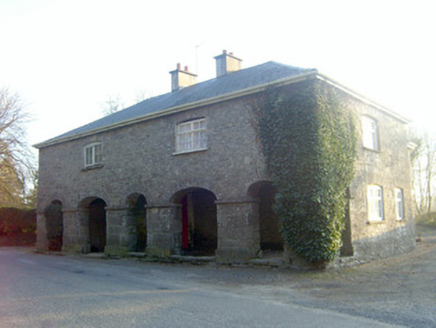Survey Data
Reg No
21900623
Rating
Regional
Categories of Special Interest
Architectural, Historical, Scientific, Social
Original Use
Garda station/constabulary barracks
Historical Use
Apartment/flat (converted)
Date
1820 - 1830
Coordinates
166445, 157772
Date Recorded
19/12/2007
Date Updated
--/--/--
Description
Detached two- or five-bay two-storey barrack, built 1825, on a rectangular plan; single-bay two-storey side elevations. In alternative use, 1837. In alternative use, 1888. Renovated, ----, to accommodate alternative use. Now disused. Replacement hipped artificial slate roof with ridge tiles, paired cement rendered central chimney stacks having concrete capping supporting terracotta pots, and uPVC rainwater goods on eaves boards. Part creeper- or ivy-covered rubble stone walls originally rendered with hammered limestone flush quoins to corners. Series of five elliptical-headed openings on tooled hammered or rough hewn limestone piers on benchmark-inscribed tooled cut-limestone plinths with lichen-spotted tooled limestone ashlar voussoirs. Square-headed central door opening in camber-headed recess with limewashed red brick voussoirs framing timber boarded door. Square-headed window openings in camber-headed recesses (first floor) with shallow sills, and hammered limestone voussoirs framing replacement timber casement windows. Road fronted.
Appraisal
A barrack representing an important component of the early nineteenth-century built heritage of County Limerick with the architectural value of the composition, one 'intended to protect Sir Richard Bourke [1777-1855] from the so-called Republican elements of Irish society [but who] is reported to have expressed no need for protection from his own people' (Ordnance Survey Field Name Book), confirmed by such attributes as the compact rectilinear plan form; the market house-like arcade demonstrating good quality workmanship in a deep grey limestone; and the diminishing in scale of the openings on each floor producing a graduated tiered visual effect. NOTE: The barrack was repurposed on a number of occasions: as 'a dispensary connected with that of Castleconnell' (Lewis 1837 I, 196); as a soup kitchen at the height of the Great Famine (1845-9); as a wood carving school 'producing fine examples of work [including] the staircase of Glenstal Abbey turned out in 1888' (cf. 21900703); a meeting room for the Ahane Cumann of Fianna Fáil; and lastly as apartments occupied by Henry "Harry" Pond and James "Jimmy" Spuddle who were veterans of the First World War (1914-9) and the War of Independence (1919-21) respectively (Moloney 2004, 41).

